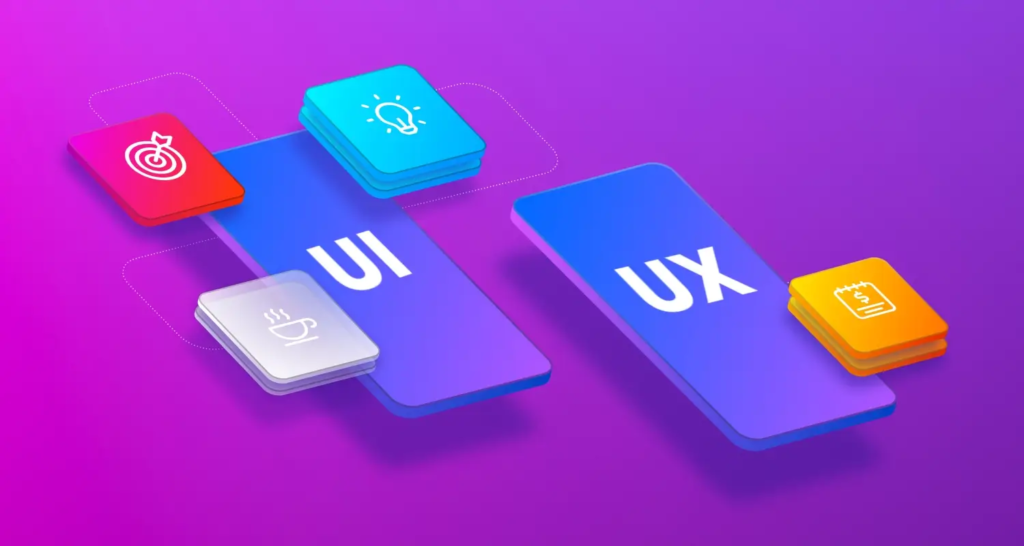
Latest Trends in UI/UX Design: Shaping the Landscape of Web Design and App Design

1. Personalization of web Design:
User-Centric Focus: UI/UX designers prioritize personalized experiences, informed by thorough user research and insights into individual preferences in both web design and app design.
Data-Driven Insights: Leveraging analytics, designers track user behavior in web and app design, enabling real-time adjustments and continuous improvement of the user experience.
Responsive Web Design: Interfaces are crafted to seamlessly adapt to various devices in both website and app design, ensuring a consistent and personalized user experience across platforms.
Customization Empowerment: Users are given control over interface settings in both website and app design, allowing them to tailor elements like colors and layouts to match their unique preferences.
AI-Enhanced Recommendations: Designers integrate AI algorithms for personalized content recommendations based on historical user interactions, fostering engagement and satisfaction in both web design and app design.

2. Simplicity:
Streamlined Interfaces: UI/UX designers prioritize simplicity by minimizing clutter and eliminating unnecessary elements, creating clean and efficient interfaces in both web and app design.
User-Centric Language: Clear and articulate language is employed to communicate instructions and information concisely in both web and app design, reducing cognitive load and enhancing user understanding.
Efficiency through Minimalism: A reductionist approach focuses on minimizing procedural steps, simplifying workflows, and optimizing processes for a more intuitive and time-efficient user experience in both website and app design.
Visual Hierarchy and Cues: Visual cues, such as contrasting colors and strategically placed elements, guide users seamlessly through navigation in both web and app design, emphasizing the importance of visual hierarchy in facilitating user understanding.
Consistency Across Platforms: Designers ensure a consistent user experience across platforms in both website and app design by maintaining a cohesive design language and reinforcing simplicity as a key principle for usability and accessibility.

3. Visual Appeal:
Harmonious Color Schemes: UI/UX designers leverage color theory to create visually appealing interfaces, using harmonious color schemes that evoke specific emotions and enhance the overall aesthetic in both web design and app design.
Typography as a Web Design Element: Typographic finesse is embraced to enhance readability and convey brand personality in both website and app design, with designers selecting fonts that complement the overall visual theme of the interface.
Graphical Elements for Impact: Graphical sophistication involves the strategic use of icons, illustrations, and images in both web and app design to not only convey information but to elevate the overall design, adding a layer of visual richness and engagement.
Aesthetic-Functional Balance: Striking a delicate balance between aesthetics and functionality, designers ensure that visual elements not only look appealing but also contribute to a seamless and user-friendly interaction in both website and app design.
Immersive Design Experiences: Interfaces transcend mere functionality, becoming immersive experiences where every visual element contributes to a cohesive and memorable user journey in both website and app design, reinforcing the importance of aesthetics in the overall user experience.

4.Accessibility:
Universal web Design Principles: UI/UX designers embrace universal design principles in both website and app design, ensuring that interfaces are accessible to users with diverse abilities and disabilities, promoting inclusivity.
High-Contrast Typography: To enhance visual accessibility, designers incorporate high-contrast typography in both web and app design, making text legible for users with visual impairments or those navigating in challenging lighting conditions.
Screen Reader Compatibility: Interfaces are meticulously designed in both website and app design to be compatible with screen readers, allowing users with visual impairments to engage with the content through audio cues and descriptions.
Keyboard Navigation: Prioritizing keyboard navigation options in both web and app design ensures that users who rely on keyboard controls, rather than a mouse, can easily navigate through the interface, enhancing accessibility.
User Testing for Accessibility: UI/UX designers conduct regular accessibility testing in both website and app design, involving users with diverse needs, to identify and address potential barriers, fostering a commitment to creating inclusive digital experiences for all users.

5.Voice Search Optimization For Web Design:
Voice-Activated Interactions: UI/UX designers are integrating voice-activated features, allowing users to interact with interfaces through natural language, promoting a hands-free and convenient user experience in both website and app design.
Natural Language Processing (NLP): Advanced NLP algorithms are deployed in both web and app design to understand and interpret user queries accurately, enabling interfaces to respond contextually and provide relevant information.
Contextually Relevant Outcomes: Designers focus on delivering outcomes that align with the context of voice-initiated searches in both web and app design, ensuring that the user receives pertinent and meaningful responses in a conversational manner.
Adaptive Interface Design: Interfaces are adapted in both website design and app design to accommodate varying speech patterns, accents, and linguistic nuances, enhancing the inclusivity of voice-activated interactions for a diverse user demographic.

Overall Impact:
In the dynamic landscape of web and app design, a transformative evolution is occurring, surpassing mere aesthetics. This shift, characterized by iterative processes and data-driven optimization, is deeply rooted in agile methodologies. UI/UX designers now prioritize cross-functional collaboration, aligning design strategies with business goals and responding promptly to user feedback in both web design and app design. Human-centered innovation takes center stage, focusing on solving real user problems and anticipating evolving needs. Responsive to cultural shifts, designers embed inclusivity and ethical practices into their creations, fostering trust in the digital realm. Prioritizing user education and empowerment, alongside user-centric performance metrics, ensures the creation of intuitive interfaces across both platforms. Embracing emerging technologies, UI/UX designers stay at the forefront of innovation, crafting future-proofed experiences for users in the evolving digital marketplace.





Leave a comment: